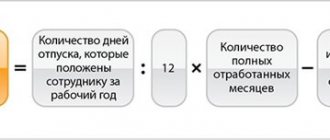The article will tell you how to pay for electronic sick leave in 2021, what has changed in the design of a certificate of incapacity for work, and what the consequences will be for violations.
Before starting to work with an electronic certificate of incapacity for work, the manager will have to issue an electronic digital signature, register on the website of the Social Insurance Fund (SIF), the employee will have to agree to issue a sick leave certificate electronically, and the medical organization will have to connect to a specialized information system. When the functionality is ready, we study how electronic sick leave is paid.
Payment period
Such insurance payments can be assigned after a person presents a sick leave certificate. For their timely accrual, the responsible person is given 10 calendar days. The payment itself is made on the day the salary is paid, which will be after the benefits are assigned (regulated by the provisions of Federal Law No. 255-F3 on compulsory social insurance).
Taking into account the fact that a special scheme has been launched and continues to operate in a number of regions, payment for sick leave in 2021 has undergone minor changes. Thus, in the case of timely submission of comprehensive data to the Social Insurance Fund by the responsible person for the assignment of benefits (within 5 calendar days) and the Social Insurance Fund makes a positive decision, the minimum period for transferring funds in 2021 is 15 calendar days (regulated by the provisions of Government Resolution No. 294 of April 21. 2011).
For employers, compliance with legally established deadlines remains very important, since delay will entail an obligation to pay compensation to their employee (Article 236 of the Labor Code of the Russian Federation).
Rules for calculating insurance experience
The insurance period must include all periods when a person received income, and social insurance contributions were transferred from this income. If there was income, but contributions were not paid from it, such a period is not included in the insurance period.
IMPORTANT . Two concepts should not be confused: “insurance period” and “work experience”. Work experience includes the time when a person worked under an employment contract, regardless of the fact of transfer of contributions. The insurance period does not necessarily coincide with the work experience. Thus, the period when a citizen was an individual entrepreneur does not apply to work experience. But if the individual entrepreneur paid social insurance contributions in case of temporary disability and in connection with maternity, this period can be included in the insurance period when calculating sick leave benefits.
The rules for calculating and confirming insurance experience were approved by order of the Ministry of Health and Social Development of Russia dated 02/06/07 No. 91 (hereinafter referred to as the Rules). According to paragraph 2 of these Rules, the insurance period includes:
- Periods of work under an employment contract.
- Periods of state civil or municipal service;
- Periods of other activities during which a citizen was subject to compulsory social insurance in case of temporary disability and in connection with maternity.
If two periods of work, service or other activity coincide in time, one of them must be included in the insurance period at the employee’s choice. He must reflect his choice in an application, which must be submitted to the accounting department. This is stated in paragraph 22 of the Rules.
Another important provision: the insurance period must be determined on the date of the first day of illness. If the bulletin is opened, for example, on June 1, then the insurance period should be calculated as of June 1.
Work with electronic sick leave and submit all related reporting through Kontur.Extern
Who pays
Law No. 255-FZ of December 29, 2006 states that the obligation regarding payment of sick leave lies with the employer. He must perform calculations, assign and transfer the required amount to the employee who provided a correctly completed document of the established type (in accordance with Order No. 624n of the domestic Ministry of Health and Social Development). Only after this can you apply to the Social Insurance Fund to receive compensation for sick leave in 2021, except for the first 3 days of the employee’s illness. For the specified period, funds are not reimbursed.
In regions where the Social Insurance Fund continues the pilot project, the employer will pay sick leave according to the usual scheme. That is, payments are made for the first 3 days of illness. The remaining amount is reimbursed by the FSS representative of this region - for the period from the 4th to the last day, which is indicated on the certificate of incapacity for work.
The FSS also pays insurance amounts for pregnancy and childbirth, as well as for caring for a temporarily disabled family member - from the 1st to the last day of illness (articles of Law No. 255-F3 and the provisions of Order No. 1012n of the Ministry of Health and Social Development).
Kinds
In connection with the adoption of new legislation in Russia, it seems possible to distinguish the following types of sick leave:
- A leaflet issued in case of illness.
- A sheet sent for medical social examination.
- Designed for sanatorium-resort treatment.
- To care for a sick family member.
- For quarantine.
- For prosthetics.
- During pregnancy.
Each of these types of sick leave differs in the procedure and timing of issuance, validity period, as well as the procedure for making payments on them.
Click to enlarge.
How is it paid?
The procedure for paying sick leave to the Social Insurance Fund in 2021 has not been changed. That is, the amount of the benefit is calculated based on the person’s average earnings, which he received over the last two years before the occurrence of the insured event. Namely – illness, pregnancy, etc.
It is worth noting that the maximum payments for a certificate of incapacity for work in 2021 are limited. But the employer can initiate additional monetary compensation - an additional payment up to average earnings. In this case, the indicated restrictions will not affect the person.
Domestic legislation determines the minimum amount of payment for sick leave in 2021. Or more precisely, the minimum value of average earnings, which is calculated based on the minimum wage. A similar value is used to calculate insurance if, for example, the average monthly salary of a worker is below the minimum wage. Other situations are also possible that require calculation based on the “minimum wage” values.
The federal minimum wage for 2021 is 9,489 rubles. obtained by calculation. Based on the provisions of the Ministry of Labor bill, the minimum wage for the next year is determined as 85% of the cost of living for the 2nd quarter of 2021 (RUB 11,163 × 85%). The average earnings for sick leave are calculated using the formula (clause 15.3 of the Regulations, approved by Decree of the Government of the Russian Federation of June 15, 2007 No. 375): Average daily earnings for payment on a certificate of incapacity = minimum wage × 24 ÷ 730
Knowing that from January 1, the minimum wage for sick leave is 9,489 rubles, you can calculate the average daily earnings. It will be 311.97 rubles.
Also see “Sick leave from the minimum wage in 2021“.
What to do after receiving sick leave from a doctor?
After the employee has been given a certificate of temporary incapacity for work, sealed by a doctor (that is, signed and stamped), he must present it to his employer on the first day of going to work.
Next, the document will be sent to the accounting department, the accountant must check that it contains the required details:
- the correctness of writing the full name of the employee and his child (relative), if the sick leave was issued for care.
- correctness and completeness of spelling of the name of the medical institution that issued the document;
- availability and correctness of specified codes;
- period of illness;
- presence of the doctor’s signature, his personal seal and the seal of the medical institution.
You also need to check the form on which the document is drawn up. After all, the employer has the right to pay benefits only if the temporary disability certificate is filled out without errors and is genuine. Only in this case does it confirm that an insured event has occurred for the bodies of the Social Insurance Fund (SIF).
New calculation in 2021
To calculate sick leave correctly, you need to take into account the main changes from 2021:
- New billing period – 2021 and 2021;
- Maximum earnings – 1,473,000 rubles (2016 – 718,000 rubles, 2021 – 755,000 rubles);
- The new minimum wage as of January 1, 2021 is 9,489 rubles;
- The number of days in the billing period is 730, for maternity leave – 731.
Calculation example
In 2021, the employee brought a certificate of incapacity for work, the period of illness was from March 12 to 22, 2021. Income subject to contributions to the Social Insurance Fund in 2021 amounted to 713,500 rubles, in 2021 - 748,300 rubles. Experience – 5 years.
- Billing period – 2016-2017, 730 days. The number of days of incapacity for work is 11.
- Let's calculate the average daily earnings and compare them with the minimum: Average daily earnings = (713,500 + 748,300) / 730 = 2002.46 rubles. The employee’s income for 2021 and 2021 is less than the limit (RUB 713,000 < RUB 718,000, RUB 748,300 < RUB 755,000). Therefore, we must take into account the actual earnings for 2016-2017 in the amount of 2002.46 rubles.
- Let's determine the percentage of sick leave payment based on length of service: Experience is 5 years, so you need to pay 80% of average earnings.
- Let's calculate the sick leave benefit: 2002.46 x 11 days. x 80% = 17,621.65 rub.
- Let's calculate the amount that the employee will receive after withholding personal income tax at a rate of 13%: The amount of sick leave tax will be: RUB 17,621.65. x 13% = 2291 rub. Amount of sick leave payable to the employee: RUB 17,621.65. – 2291 rub. = 15,330.65 rub.
- Let's determine the source of sick leave payments: The first three days of illness are paid at the expense of the employer (RUB 4,805.90). The remaining 8 days are subject to reimbursement from the Social Insurance Fund. In the calculation of 4-FSS we will show 12,815.75 rubles. is the amount to be reimbursed.
How long can you be sick without sick leave in accordance with the law?
Missing work according to modern standards is called absenteeism. Previously, there was a provision according to which an employee had the right to take three days of absence from work at his own expense. Now this provision has lost force.
Now the employer independently establishes regulations regarding how and for how long an employee can be away from the workplace without issuing a sick leave.
At the same time, the employee retains the right to ask for time off at his own expense if there are valid personal or family circumstances. In the event of the death of a close relative, the employee may also not be at work for several days without receiving a sick leave certificate.
Electronic sick leave certificates in 2018
In 2021, employees can bring not only paper sick leave certificates for payment, but also electronic sick leave numbers. The latter can be issued by those medical organizations that have connected to the information interaction system with the FSS. In this case, the doctor does not fill out the paper version, but enters the data into an electronic database or electronic medical record when opening a sick leave. An electronic certificate of incapacity for work is equivalent to a paper document.
To work with electronic sheets, an organization will need a personal account at cabinets.fss.ru. Here the accountant sees the employee’s sick leave and fills out his part of the sheet.
Special cases of salary payment
In some cases, the standard rules for transferring salaries do not “work”.
Let's list some of them:
If an employee wants his salary to be transferred to two different accounts - for example, an advance to a card of one bank, and the main salary to another. This happens if, for example, his loan debt is automatically written off from his card.
Formally, there are no obstacles to such a solution, but this method of calculation is not always convenient for accounting. However, this is practiced.
Transfer of wages to a third party
For example, a wife or an adult child. In some cases, this is practiced (and in this case we are not talking about alimony or judicial deductions, but specifically about the full transfer of wages). All transfers for insurance and pensions are still transferred to the account of the employee himself, it’s just that his money goes to another person by proxy.
Transferring salaries several months in advance
If the employer does not mind, and the employee has provided him with all guarantees that he will work out this period, then this is possible. However, more often the company simply provides its employee with a loan or an interest-free loan, which is gradually deducted from the salary.
Payment of wages in kind
We are talking about the issuance of earnings from the company's products. Currently, this is practiced very rarely, since money circulation is well established. However, in some rural areas such payment of wages is quite possible. For example, remuneration for a collective farm employee is given in the form of food. In this case, salaries must also be paid twice a month with a difference of no more than 15 days.
When collaborating on gray wages, not only the employer, but also the employee is responsible. What are Gross and Net salaries and how do they differ? Our article will tell you about this.
Surely you have often heard the word “accounting entries”. What are they and what are they for? Read here.
How is an advance paid for the first half of the month?
The Labor Code does not regulate the nuances of advance payment.
The procedure for issuing an advance on wages is no different from paying wages for the month:
- a statement is drawn up in form T-53;
- the employee signs in a specially designated cell of the statement and receives funds;
- after payment of the advance, this statement with signatures is attached to the cash receipt in form KO-2;
- the accounting records the posting Dt 70 Kt 50.
The advance can also be paid to the employee’s bank card. Before this, the employer must obtain written consent from the employee to receive the salary into a bank account.
How to fill out such an application, read the article “Application for transferring salary to a card - sample”.
The posting when paying an advance to an employee on a card looks like this: Dt 70 Kt 51.
If you have access to K+, see step-by-step instructions for paying salaries. If you don't have access, get a free trial and go to the Salary Guide.
How to keep track of salaries in accounting, see here.
ATTENTION! The employee has the right to change the credit institution by notifying the employer. From 08/06/2019, the notice period is no later than fifteen calendar days before the day of payment of wages. (clause 4 of article 136 of the Tax Code of the Russian Federation).
Personal income tax when issuing an advance to employees
In general, there is no need to withhold personal income tax from the advance payment. This has been pointed out more than once by government departments (letters from the Ministry of Finance dated 02/13/2019 No. 03-04-06/8932, dated 07/13/2017 No. 03-04-05/44802, Federal Tax Service dated 04/29/2016 No. BS-4-11/7893, dated 03/24/2016 No. BS-4-11/4999). Officials justify their point of view as follows:
- the date of actual receipt by the employee of income in the form of wages is the last day of the working month (clause 2 of Article 223 of the Tax Code of the Russian Federation);
- At the time the advance is issued, income has not yet been generated, which means there is nothing to tax.
Therefore, personal income tax must be withheld only upon final payment to the employee for the month worked.
But if the advance payment date is set on the 30th day and it is the last day of the month, problems cannot be ruled out, since tax authorities may recognize the last day of the month as the date of actual receipt of income, and judges may support them (see the Supreme Court ruling dated May 11. 2016 No. 309-KG16-1804).
Also inconvenient will be the date of payment of the advance for the 1st half of the month, set on the 15th day of the month, since the employer will be obliged to pay the 2nd part of the salary on the 30th day of the current month. But the time sheets for the time worked by employees will reach the accounting department no earlier than the 1st day of the next month. Consequently, the accountant simply physically will not be able to calculate wages and pay them to employees on the 30th.
In what cases personal income tax is withheld from the advance, find out here.
ConsultantPlus experts explained in detail how to correctly reflect the advance in form 6-NDFL. To do everything correctly, get trial access to the system and go to the Ready solution. It's free.
Methods for assigning an advance
The algorithm for assigning an advance payment is also not established by law and is determined by the employer himself. Various departments in their letters recommend determining the amount of the advance in proportion to the time worked by the employee (letters from the Ministry of Labor dated August 10, 2017 No. 14-1/B-725 and Rostrud dated September 26, 2016 No. T3/5802-6-1).
At the same time, according to officials, the advance amount should include a number of compensation and incentive bonuses, for example, for length of service or for night work. But bonuses, which depend on the achievement of planned indicators, as well as compensation payments calculated after fulfilling the monthly working hours, are not included in the calculation of the advance payment. An example of such compensation is payments for overtime work or work on non-working days.
Thus, officials propose to calculate the amount of wages twice a month, taking into account the actual amount of work performed or the time worked by each employee. The formula for calculating the advance in this case is as follows:
A = Zp ÷ Knd × Kfd,
Where:
Salary - salary;
Knd - standard number of working days;
Kfd - actual number of days worked.
Example 1
Alternativa LLC sets the advance payment deadline for the 16th day of each month, based on the time actually worked by each employee. According to the timesheet, sales department employees worked the following amount of time:
| FULL NAME. employee | Job title | Number of days worked in the 1st half of the month | Salary, rub. | Advance amount, rub. | Calculation of the advance amount |
| Stepanov A. M. | Sales Director | 10 | 40 000 | 18 181,82 | 40 000 ÷ 22 × 10 |
| Artemov L. E. | Sales Manager | 7 (I was on vacation for 3 days without pay) | 25 000 | 7 954,55 | 25 000 ÷ 22 × 7 |
| Bushmin A.V. | Sales Manager | 10 | 25 000 | 11 363,64 | 25 000 ÷ 22 × 10 |
| Bushmin A.V. | Logistician (internal combination) | 5 | 10 000 | 2 272,73 | 10 000 ÷ 22 × 5 |
| Gordienko T. E. | Sales Manager | vacation | 25 000 | — | — |
Employee Bushmin A.V. combined the position of sales manager and logistics manager for 5 days, and therefore will receive an advance payment for 2 positions.
Artemov L. E. was on vacation at his own expense for 3 days. Consequently, he is not entitled to an advance for these days.
Manager Gordienko T.E. will not receive an advance payment, because he was on regular vacation.
This approach to calculating an advance payment is quite time-consuming and labor-intensive; only small businesses with a small staff can choose it. As a rule, large companies set a fixed advance. Let's consider the calculation algorithm and the rules for paying an advance in a fixed amount.
How to calculate the amount of a fixed advance
The fixed amount for the advance can be set:
- in total terms;
- in the amount of a certain percentage of the salary.
By paying an advance in a fixed amount, for example 10,000 rubles, the employer is at great risk. The risk is due to the fact that the employer is obliged to pay an advance in a constant amount, regardless of whether the employee was working or was, for example, on sick leave. Also, at the end of the month, the amount of the entire salary may be less than the advance paid. Therefore, employers rarely choose the first option for paying an advance.
The most common option is to determine the amount of the advance as a percentage of the salary. Since the Ministry of Health and Social Development indicates that the amount of the advance and salary should be approximately equal (letter dated February 25, 2009 No. 22-2-709), employers, as a rule, set the advance at 40–50% of the salary. But if the amount of the advance is set at ½ of the amount of earnings, then salaries for the first and second halves of the month will be very different. Let's look at an example.
Example 2
The employee's salary is set at 40,000 rubles. The personal income tax amount will be 5,200 rubles. (40,000 × 13%)
| Advance amount | Prepaid expense | Salary |
| 40% | 16 000 (40 000 × 40%) | 18 800 (40 000 – 5 200 – 16 000) |
| 50% | 20 000 (40 000 × 50%) | 14 800 (40 000 – 5 200 – 20 000) |
As can be seen from the example, the amount of monthly salary when paying an advance of 50% is significantly less than the amount of the advance itself.
The employer decides independently how to pay the advance in 2020-2021. We recommend setting the advance at 40-45% of the amount of earnings with a correlation to the time actually worked: by the date of payment of the advance, the accountant is provided with time sheets of the time worked by employees, and the salary amount for the 1st half of the month is adjusted to the number of days worked.
Let's consider the procedure for calculating such an advance using the example of manager L. E. Artemov.
Example 3
The employee's salary is 25,000 rubles. We will calculate the advance based on 40% of the salary and the correlation for the actual time worked.
The planned amount of the advance is 10,000 rubles. (25,000 × 40%).
But since the employee worked 7 days instead of 10, the amount of advance payment to be issued will be 7,000 rubles. (10,000 ÷ 10 × 7).









